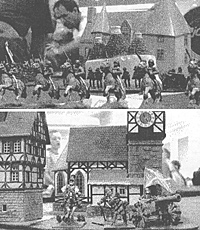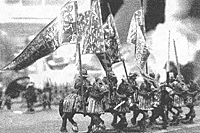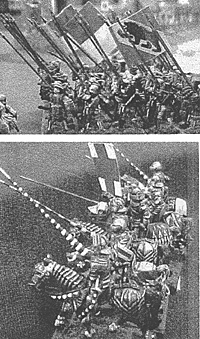 The French Wars of Religion were a series of French civil wars, of the most uncivil type. The French government was in the hands of Catherine de Medici (an Italian) and her two sons. They were an amoral, Machiavellian lot of incompetents, who saw defeat for them if either the rebellious Huguenots (Protestants with a Calvinist twist) or the Catholic extremists under the Guise family (who had a lot of power and even more ambition towards the throne) were to win. Hence, Catherine was constantly patching up the peace as a means of prolonging her tenure.
The French Wars of Religion were a series of French civil wars, of the most uncivil type. The French government was in the hands of Catherine de Medici (an Italian) and her two sons. They were an amoral, Machiavellian lot of incompetents, who saw defeat for them if either the rebellious Huguenots (Protestants with a Calvinist twist) or the Catholic extremists under the Guise family (who had a lot of power and even more ambition towards the throne) were to win. Hence, Catherine was constantly patching up the peace as a means of prolonging her tenure.
The French Wars of Religion produced a fair number of brave and valiant commanders, but seemingly none who knew what they were doing. Few battles show this mutual bungling to better effect than the opening Battle of Dreux.
The possibility that a war could break out at all was the result of the French failure in Italy. The Catholics had been massacring the Huguenots for many years, but one result of the total failure of France’s campaigns in Italy was that there were a large number of former soldiers and officers wandering about. This new war gave them employment, excitement, and loot.
The Huguenots had formed an army under Conde and Admiral Coligny (yes, an admiral does make for an unlikely cavalry commander). Having failed to awe Paris, they were moving towards Dreux, on their way to Normandy. Conde did not seem to think that scouting had any value.
The Catholic Army had three luminaries in charge. The elderly Constable of France, Montmorency, became the leader by default, once the Duke of Guise decided to control nothing more than his own personal regiments. Montmorency’s second in command was Marshal of France, St. Andre. Montmorency, with many years of experience, scouted the enemy and thereby discovered his intentions. Therefore, he maneuvered the Catholic Army into an excellent position to prevent the Huguenots from reaching Dreux.
The Huguenot Army of possibly 8—9,000 men was strong in cavalry. German co-religionist reiters—heavily armored cavalry who used the caracole supported the excellent French cavalry—still charging in line using the lance. Their newly raised infantry were stiffened by some German landsknechts. Only 4 of their cannon were deployed during the battle.
The Catholic Army had as many as 20,000 men. They were heavy in infantry, including Germans, Italians, and an enormous force of 6,000 Swiss pike men. They were weaker in cavalry than the Huguenots, both in quantity and quality. They deployed 22 cannon.
The Catholic Army was deployed on the reverse slope of high ground that stretched between the Rivers Eure and Blaise. The rivers formed an enormous ‘V’, with the point back at Dreux. Forests covered the ground by the rivers on the flanks. At the edge of the forests were two villages.
The Constable, Montmorency, held the left, with troops in the village of Blainville and the Bois de la Place (a forest). He had his infantry in front of the village, with his portion of the center covered by his French infantry and then the enormous pike bloc of Swiss.
 Marshal St. Andre hid his troops behind the artillery-fortified village of Epiney and the Bois de la Marmousse. The Duke of Guise hid his command behind St. Andre.
Marshal St. Andre hid his troops behind the artillery-fortified village of Epiney and the Bois de la Marmousse. The Duke of Guise hid his command behind St. Andre.
Meanwhile, Conde and Coligny stumbled on, quite oblivious of the presence of an army of at least twice their numbers. Then cannon shot from the Blainville battery went tearing through their ranks. They sorted out their army, but because they still did not think it wise to investigate the enemy positions, they failed to notice the troops of St. Andre and Guise. Not wanting to charge uphill into this unflankable funnel, Conde turned left, and began to march his army around the Catholics. Presenting his flank to his stronger opponent less than a mile away proved too much of an enticement, so Montmorency moved forward. St. Andre and Guise failed to follow.
The Huguenots turned upon the Catholics and attacked. Admiral Coligny’s cavalry rode down the heavy gendarmes of Montmorency, wounded the Constable and took him prisoner. They turned upon the French infantry and scattered it. Then they swept aside the Catholic light cavalry, took the town of Blainville and captured the cannon. Unfortunately, they kept on going. Much like the Royalist cavalry in the English Civil War, they swept on after the routed French left, sacking their camp, and generally dispersing about the countryside.
Some fugitives from the routed French left reached Paris. When the Queen-Dowager heard the news of her Royal Catholic Army, all she could say was, ‘In that case we shall have to learn to say our prayers in French.’
With the Catholic Army’s commander a wounded prisoner of the Huguenots, and their left flank crushed and in flight, the battle should have been a Huguenot victory. And well it might have been, except for the presence of the Huguenot commander, Conde. Conde decided—why, God only knows—that he must take his cavalry and ride down the 6,000 man elite Swiss pike bloc, which was bristling with 18’ steel-tipped pikes. First Conde dashed each of his cavalry units in turn against the Swiss. Then, not content with the ruin of his cavalry, he threw his infantry units against the Swiss. They all failed.
Only now did St. Andre and the Duke of Guise come out of hiding and fall upon the beaten and exhausted remnants of the Huguenot left. The landsknechts surrendered, the others died or fled. Conde, having gathered a few mounted men to him, drove into the center of his attackers, where his horse was killed and he was taken prisoner.
With both commanders prisoner of their enemy and the armies exhausted, one might have thought the Battle of Dreux over. Think again.
 At this point, Admiral Coligny, having heard of the plight of his left, gathered together a little over a thousand of his cavalry and came charging out of the dusk against the Catholics under St. Andre and the Duke of Guise. Again, the Huguenot cavalry rode over the Catholic cavalry, and St. Andre, the new Catholic commander, was unhorsed and captured. Alas, St. Andre was captured by Baubigny, who had been robbed, and dishonored by St. Andre after St. Andre had had Baubigny’s father murdered. The result? Baubigny shot St. Andre dead.
At this point, Admiral Coligny, having heard of the plight of his left, gathered together a little over a thousand of his cavalry and came charging out of the dusk against the Catholics under St. Andre and the Duke of Guise. Again, the Huguenot cavalry rode over the Catholic cavalry, and St. Andre, the new Catholic commander, was unhorsed and captured. Alas, St. Andre was captured by Baubigny, who had been robbed, and dishonored by St. Andre after St. Andre had had Baubigny’s father murdered. The result? Baubigny shot St. Andre dead.
Admiral Coligny gathered together the Huguenot survivors, and pressed on into Normandy, which had been his original objective. The Duke of Guise, now the Catholic commander, took the Catholic Army to besiege Orleans, where a Huguenot fanatic assassinated him.
The Queen-Dowager, Catherine de Medici then sued for peace between the Catholics and Huguenots. Nothing had been decided, but Part II of Bring in the Clowns would have to wait for four years, when the war broke out anew, and at the Battle of St. Denis, Conde and Coligny squared off against Montmorency again.
‘It is hard to find in history more perfect examples of military incapacity continued over a considerable period of time than those of Montmorency and Conde, both of whom were regularly beaten in action. At Dreux, by a comic and unique instance of righteous nemesis, each was taken prisoner by the other’s army, because both chose to act as cavalry brigadiers rather than responsible commanders-in-chief.’--Sir Charles Oman
Send in the Clowns Part II: The Battle of St. Denis
Back to Novag's Gamer's Closet Spring 2003 Table of Contents
Back to Novag's Gamer's Closet List of Issues
Back to MagWeb Master Magazine List
© Copyright 2003 by Novag
This article appears in MagWeb.com (Magazine Web) on the Internet World Wide Web. Other articles from military history and related magazines are available at http://www.magweb.com